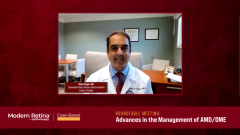
Impressions and Takeaway Points From Patient Case #2
A retina specialist discusses impressions and key takeaway points from the case of a 73-year-old female with treatment experienced nAMD.
Rishi Singh, MD: My initial impression is this is a patient who has significant recalcitrant disease despite having multiple injections. You always have to look to see why that is. Is it that we gave the wrong medication? Is the wrong injector being used? What is the reason for this? I think that this patient helps us because it really shows us that patients may be undertreated. As you saw, this patient had a significant amount of fluid even before they were enrolled within the trial, and therefore, again, that's where we see the benefits of going on mandated every-8-week therapy with Eylea—aflibercept—and having a good clinical outcome as a result of that.
The most common barriers for a patient with age-related macular degeneration usually are the fact that they have vision loss and that they're old, and those together can prevent them from having the ability to transport themselves to and from appointments. Then they go locally to doctors if they can, but they lack the integrated network. That’s a real problem because it can lead to adverse outcomes for that patient.
I’ve gone through this evolution where I’ve actually used all 3 of these treatments—treat and observe, treat and extend, and monthly injections—in the same patient over time. It just depends on what stage you’re in. Most of us treat to the point of dryness, so the retina's totally dry. We've then gone to a treat-and-extend format where we inject at times when the retina's dry to extend the interval even further to see how far out you can go. There are very important key differences in those approaches with regards to that. Now as the treatment has been shown only in 1 study to be equivalent to even monthly dosing studies, you have to be very careful about using any sort of data from a PRN [pro re nata/as needed] approach because it may lead to some adverse events over time.
The ability for us to see the data from TENAYA [NCT03823287] and LUCERNE [NCT03823300] at the year-2 efficacy point was reassuring in many ways. Many patients with good vision were enrolled in the study, and there was somewhat of a decline in the overall vision rate during the course of the trial, yet they were able to be maintained on very, very long intervals of retreatment, every 16 weeks or every 12 weeks, depending on the study you're looking at. Again, it’s just a reaffirmation of the fact that the study results were impactful, they were beneficial, and we'll be using them in clinical practice to make judgments and treatment decisions.
What really stuck out to me during the conference was that we had so many great clinicians there, and they were giving their input on how they would manage some of these patients. I think it's very hard to come up with a cookbook kind of method; there's a very personalized approach for many patients. I think that many of the answers were correct; it just depends on what patient you're talking to and discussing. Overall, I thought the discussion was very, very supportive of multifactorial treatments, whether it's the fact that you give these injections as needed or PRN, or you give them monthly, or you give them bimonthly, or you do some variation of that. None of us have that concern or issues with any of this stuff happening.
I'm glad to have given this presentation. I think case discussions in particular can be really impactful regarding our ability to synthesize some of the data we're utilizing in clinic and apply them back to our patients. I want to thank you all for watching this Modern Retina™ program. We hope you found this presentation to be rich and informative. Thank you very much.
Transcript Edited for Clarity
Newsletter
Keep your retina practice on the forefront—subscribe for expert analysis and emerging trends in retinal disease management.
















































